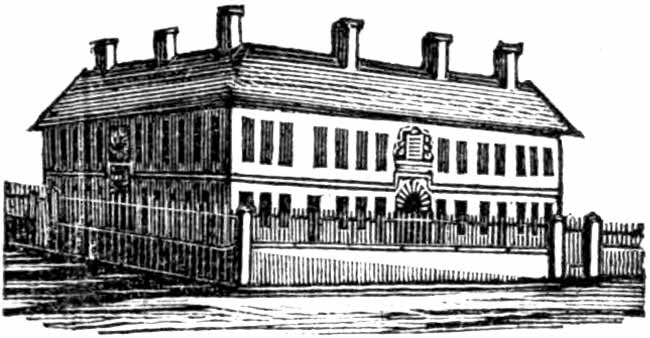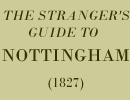< Previous | Contents | Next >
the porter, a trifling douceur to whom, procures a ready admission, to view that elevated and delightfully situated edifice
THE CASTLE:

This majestic ornament of the town of Nottingham, owes its imposing appearance less to the stateliness of the building itself, than to the commanding hill which it surmounts. On the south and west, the rock is nearly perpendicular, and rises one hundred and thirty-three feet above the level of the Leen, which runs at its foot. An extensive sweep of rich and beautiful country is thus brought under the eye; comprehending the park, the extensive level of the meadows, the valley of the Trent, and that softly swelling range of hills which rise on the opposite side of that noble river, distributed into richly cultivated enclosures, and bearing on their bolder fronts the dark foliage of overhanging woods. On the east, a bird's-eye view of a great part of the town presents itself, sloping down the nearer declivity, and exhibiting its churches, and several of its best built streets, on the side of the opposing hill.
The ancient castle, which before the invention of artillery, was impregnable, was unquestionably a place of great strength, but it was dismantled soon after the civil wars of Charles the First, and reduced to a place of ruins.
The present castle is comparatively a modern erection; the site of it, and the park, &c. being given by the crown, to the Newcastle family. The foundation of the present building was commenced by William, Duke of Newcastle, in 1674, and was finished in 1679, at a total expense of £14,002. 17s. 11d. Time and want of complete occupation, has made great inroads on this beautiful building, which has lately undergone considerable repairs. The east front, and keystones over the windows, are embellished with a set of portraits which retain their pristine beauty; and the stone heads of the upper windows present also a specimen of tasteful sculpture in imitation of drapery. The equestrian statue in the same front was carved by Wilson, an ingenious sculptor, out of a solid block of stone, which was brought from Donington, in Leicestershire. The name of the architect, who built the edifice, was March, a Leicestershire gentleman. The only curiosity now exhibited, is Mortimer's Hole, a subterraneous passage from the Castle-terrace on the south side of the rock, In the minority of Edward III., after the murder of his deposed father, his mother Isabella lived with Mortimer, Earl of March, in this castle; the young King being ashamed of his mother's conduct, by advice of his council, determined, with a body of friends, to seize Mortimer in this apparently impregnable fortress. The aid of Eland, constable of the castle was obtained, and he engaged to introduce young Edward and his party through the secret passage, which appears to have been unknown to the Queen and her paramour, during the night. Mortimer was seised in the presence of the Queen, whose prayers and entreaties for his preservation were unavailing. He was tried at Westminster, and condemned and executed as a traitor. A parliament was subsequently held at Nottingham, which deprived the Queen of her dower, and settled on her £1000. a-year for life; thus ended this royal and fetal amour, and from this circumstance, the celebrated passage received its present name. Leaving the castle, we pass down Park-street, where, on the south side stands
THE SCOTS' BAPTIST CHAPEL,
in which there is service at half-past ten, two, and half-past six every Sabbath, and on Wednesday evenings, at seven. It is sixty feet by twenty-seven; has lately been repaired, and though the date of its erection is lost, it is supposed to be the third dissenting chapel erected in Nottingham. It was formerly occupied by the Particular Baptists, under the pastoral care of the Rev. R. Hopper, but the present minister is Mr. Samuel Ward.—Immediately adjoining is

COLLIN'S HOSPITAL.
Another of those splendid charities which emanate from the family of the Smiths. Abel Collin, by his will, dated in 1704, left a large property to his nephew, Mr. Thomas Smith, for building and endowing this hospital. In 1709, Mr. Smith executed the founder's will, by building the present hospitals, which consist of twenty-four convenient dwellings, for the reception of a like number of poor widows and widowers, whose latter days are made comfortable. Each dwelling consists of a house-place and closet on the ground floor, and two chambers above, and the whole are kept in a very good state of repair. There is a spacious paved yaid, and the premises are inclosed by a wall, surmounted in the principal parts with iron palisades. Each inhabitant has four shillings a week, and two tons and a half of coals annually. Upon a stone, in the north front, is the following inscription:—
This Hospital by the
appointment of Abel Collin, late
of Nottingham, Mercer,
deceased, who in his life was of an
extensive Charitie to the Poor of
all Societies, and at his death by
his last Will and Testament, left a
competent Estate for erecting &
endowing the same; was
by his Nephew and Executor
Thomas Smith begun & finished in
the year 1709.
![]()
On the opposite side of the street, on the east, formerly called Quaker-lane, but now known by the name of Spaniel-row, is the
QUAKER'S MEETING HOUSE,
which was built in 1737, and cost only £337. 1s. 7d., but it has been considerably Improved by the Society of Friends, who are somewhat numerous in this town and highly respectable. It is a neat unobtrusive edifice, separated from the street by a small paved yard and a wall. The Quakers formerly had a burying ground in Walnut-tree-lane, but it being full, another piece of ground has been devoted to this purpose, on the north side of Park-street, opposite to Spaniel-row.—Park-street here changes its name to Friar-lane, for in Friar-yard, now belonging to Mr. Bakewell, the woolstapler, formerly stood a convent for the Carmelites, or White Friars, and recently there have been found on this site, a number of human bones, which no doubt were deposited in the burying-place of this ancient order. On the south side of this street, nearly opposite Friar-yard, a new place of worship, to be called
FRIAR-LANE MEETING HOUSE,
is now erecting for the use of a congregation of Independents, under the pastoral care of the Rev. J. Gilbert The building is of brick, stuccoed, in the Gothic style, and the front ornamented with a tower on each side. The whole front is forty-six feet six inches wide, and the building, including chapel and school-rooms, is seventy-six feet long. The house at the bottom of Friar-lane, at the corner of Wheeler-gate, now occupied by Mr. Bailey, and known by the appellation of the Moot-hall wine vaults, is built on the site of the ancient Moot-hall, which was used as a court of justice, when Nottingham was divided into two boroughs, the French and the English, and till the year 1714, separate juries were empannelled, and prisoners tried in the two jurisdictions, the town being divided by a line running from the Forest, and on Milton-street, Clumber-street, Bridlesmith-gate, Drury-hill, Sussex-street, and over the Meadows, to the Trent-road, the eastern division being called the French borough, and the western the English. This distinction is now known no longer, the whole town being under one jurisdiction.
